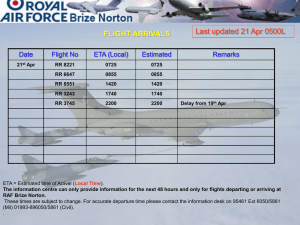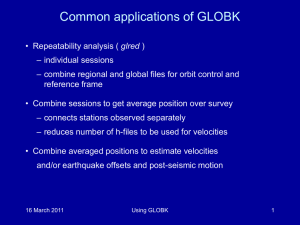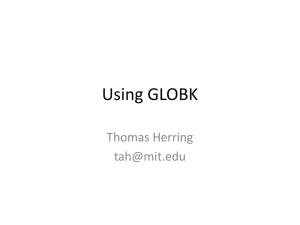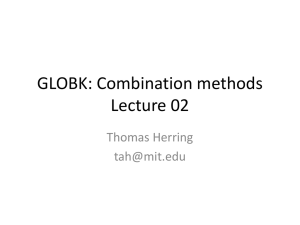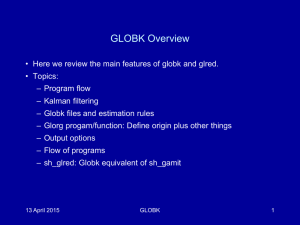Fundamentals of GPS for geodesy
advertisement
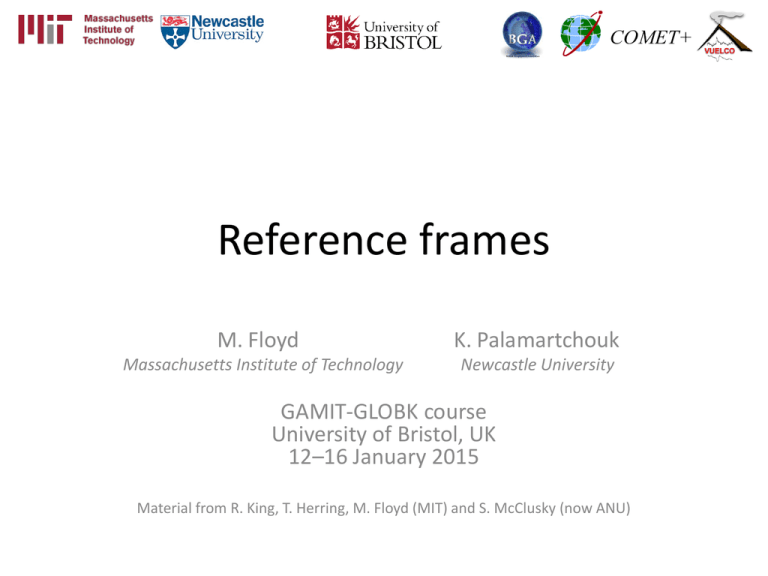
Reference frames M. Floyd K. Palamartchouk Massachusetts Institute of Technology Newcastle University GAMIT-GLOBK course University of Bristol, UK 12–16 January 2015 Material from R. King, T. Herring, M. Floyd (MIT) and S. McClusky (now ANU) Basic issues in reference frame realization • Concept is to align the estimated site positions and possibly velocity to a set of well defined locations that have physical significance for the analysis being performed (e.g., PBO we align to a realization of the North America plate based on ITRF2008. • GLORG is the module which does this and computes the covariance matrix of the aligned solution in the reference frame chosen. • Transformation is often called an N-parameter Helmert transformation: – N=3 translation only (could also be just rotation) – N=6 translation and rotation – N=7 translation, rotation and scale • In GLOBK analyses, you need to decide – – – – How many parameters (3/6/7) Sites to use to determine the parameters Values of the positions/velocities of the reference frame sites Weight to be given to heights in computing the transformation parameters. Choices of reference frame • Choose your reference frame based on your geophysical objectives – Velocities in ITRF are difficult to interpret visually from a geophysical perspective • Local surroundings of a volcano • One side of a fault • Upper plate of a subduction zone • Major plate reference frame – Major plates are often chosen to conform with conventional perspectives of velocity solutions – Relative to Eurasia, Nubia, North America, South America, etc. – But don’t feel restricted by this. Sometimes your geophysical discussion is best visualized relative to any stable boundary of a deforming region • Regional reference frame – Central Valley of California, non-deforming part of Anatolia, smaller coherent regions, etc • Local reference frame – Sites near but outside the influence of a volcano, geothermal field, etc. Ways to define a reference frame • Create an apr-file for use by glorg 1. Apply known rotation rate to apr-file (e.g. itrf08_comb.apr → itrf08_comb_eura.apr) 2. Zero velocity apr-file records (and iterate using sh_exglk to create updated apr-file) • Define set of sites (must be included in GAMIT processing or other H-file input to GLOBK) which define stable region 3. plate in globk command file Reference frame implementation • Any vector may be mapped from one coordinate system to another by the application of – Translation (affects position of co-ordinate origin) – Rotation (affects orientation of co-ordinate axes) – Scale (affects length of co-ordinate axes) 1: Translation 2: Rotation • Rotation vector, ω, is defined as in the direction of the rotation axis with length equal to the magnitude of angular rotation • Displacement (or velocity) vector then makes a right-handed triplet with the rotation vector, ω, and radial vector, p. 3: Scale Helmert transformation • Position • Velocity • Usually, the terms Rv and sv are very small and can be neglected (< 10-6 rad × < 0.1 m/yr and < 0.1 ppb × < 0.1 m/yr, respectively) Examples • Expressing velocities in ITRF is not very meaningful or useful when we want to look at the deformation at a plate boundary, e.g. the San Andreas Fault system • Better to look at velocities with one side “fixed” so we can see what the other side is doing relative to it NA PA NA PA What does “with respect to” mean? • Horizontal motions are restricted to the surface of the Earth, therefore the Helmert transformation may not contain translation or scaling of position terms 1. 2. 3. 4. 5. Set v’ to zero for all sites that you wish to estimate all other velocities with respect to Estimate the best-fit transformation parameters, e.g. by least squares estimation, to achieve this minimization of velocities in a region Apply the estimated transformation to all velocities All velocities are now “with respect to” the chosen subset The subset could be, for instance, all on one tectonic plate, or any given region from which you wish to see the deformation Reference frames in Geodetic Analyses • Output from GAMIT – Loosely constrained solutions – Relative position well determined, “Absolute position” weakly defined – Need a procedure to expressed coordinates in a well defined reference frame • Two aspects – Theoretical (e.g., rigid block, mantle-fixed, no-net-rotation of plates) – Realization through a set of coordinates and velocities • “finite constraints” : a priori sigmas on site coordinates • “generalized constraints” : minimize coordinate residuals while adjusting translation, rotation, and scale parameters • Three considerations in data processing and analysis – Consistent with GPS orbits and EOP (NNR) • not an issue if network small or if orbits and EOP estimated – Physically meaningful frame in which to visualize site motions – Robust realization for velocities and/or time series Frame definition with finite constraints • • • • Applied in globk (glorg not called): We do not recommend this approach since it is sensitive to over-constraints that can distort velocities and positions Example: apr_file itrf08.apr apr_neu all 10 10 10 1 1 1 apr_neu algo .005 005 .010 .001 .001 .003 apr_neu pie1 .002 005 .010 .001 .001 .003 apr_neu drao .005 005 .010 .002 .002 .005 … Most useful when only one or two reference sites or very local area. Disadvantage for large networks is that bad a priori coordinates or bad data from a reference site can distort the network Frame definition with generalized constraints • Applied in glorg: minimize residuals of reference sites while estimating translation, rotation, and/or scale (3 -7 parameters) apr_file itrf08.apr pos_org xtran ytran ztran xrot yrot zrot stab_site algo pie1 drao … cnd_hgtv 10 10 0.8 3. stab_it 4 0.5 2.5 k k’ q k d i o’ a j’ o i j • All reference coordinates free to adjust (anomalies more apparent); outliers are iteratively removed by glorg • Network can translate and rotate but not distort • Works best with strong redundancy (number and [if rotation] geometry of coordinates exceeds number of parameters iloading effects j Stabilization using a Global Set of Sites • • Use 40 or more sites with good velocities determined in the ITRF2008 frame The itrf08_comb.apr file, when used together with itrf08_comb.eq to account consistently for instrumental changes over time, provides the widest choice of sites, 1992-2013. • Combining your solution with the MIT or SOPAC global h-files offer access to over 100 sites without having to include them in your GAMIT processing. – You need just 4-6 common sites, which should be of high quality but need not be well know in ITRF2008 since these “tie” sites do not need to be in your frame-realization list. • For global ITRF stabilization, you can use the hierarchical list igb08_heirarchy.stab_site in gg/tables • Although a global frame may be a convenient way to do the stabilization, it is usually not necessary for regional studies. Stabilization using Regional or Local Sites • • If your area of study has a robust cGPS network (10 or more well-distributed sites) with accurate a priori velocities, then glorg stablization is robust and little thought is involved (glorg will automatically discard the one or two sites which may be weak or inconsistent) If your region is short on cGPS stations with well-known coordinates, you will need to think carefully about the choice of sites to include in your solution and use the initial stabilization. A stabilization site should have – high quality data over the full span of your study – coordinates well-known in ITRF2008 – Provide symmetric coverage around your study area (except that if the region is small enough, a translation-only stabilization may be possible and distribution is less important) IGS (IGb08) reference frame core network http://igscb.jpl.nasa.gov/network/refframe_core.html IGS (IGb08) reference frame network http://igscb.jpl.nasa.gov/network/refframe.html Use of Global binary H-files • Include global h-files … or not ? For post-2000 data not needed for orbits • Advantages – Access to a large number of sites for frame definition – Can (should) allow adjustment to orbits and EOP – Eases computational burden • Disadvantages – Must use (mostly) the same models as the global processing – Orbits implied by the global data worse than IGSF – Some bad data may be included in global h-files (can remove) – Greater data storage burden Use of Global binary H-files • • • • • Include global h-files … or not ? For post-2000 data not needed for orbits Advantages – Access to a large number of sites for frame definition – Can (should) allow adjustment to orbits and EOP – Eases computational burden Disadvantages – Must use (mostly) the same models as the global processing – Orbits implied by the global data worse than IGSF – Some bad data may be included in global h-files (can remove) – Greater data storage burden MIT hfiles available at ftp://everest.mit.edu/pub/MIT_GLL/HYY When using MIT files, add apr_svant all F F F to globk command file to fix the satellite antenna offsets If SOPAC, use all “igs’ h-files to get orbits well-determined Velocities and Time Series • • • The criteria for stabilization are different for velocity solutions and time series Velocity solutions: – Physical reference is important – Not so sensitive to station dropout (solution holds the frame together) Time series: – Physical reference is not important – Sensitive to station dropout – Best representation of the statistics of the velocity solution is stabilization using ALL the well-determined sites from the velocity solution, now in a common frame a priori coordinate files • • • We now distribute, and encourage GAMITeers to use, a set of apr-files that are a concatenated set of coordinates for all sites that are, in some present or past version, formally defined in the ITRF (531 sites or 891 including those in IGS cumulative solution) Found in ~/gg/tables/ and use in apr_file command or glorg command file These are also rotated to major plates using the Euler poles of ITRF2008-PMM (Altamimi et al., 2012) – – – – – – – – – – – – – – – – itrf08_comb_amur.apr (relative to Amurian plate) itrf08_comb_anta.apr (Antarctica) itrf08_comb_arab.apr (Arabia) itrf08_comb_aust.apr (Australia) itrf08_comb_carb.apr (Caribbean) itrf08_comb_eura.apr (Eurasia) itrf08_comb_indi.apr (India) Itrf08_comb_na12.apr (North America, after Blewitt et al., 2013) itrf08_comb_nazc.apr (Nazca) itrf08_comb_noam.apr (North America) itrf08_comb_nubi.apr (Nubia) Itrf08_comb_nu13.apr (Nubia, after Saria et al., 2013) itrf08_comb_pcfc.apr (Pacific) itrf08_comb_soam.apr (South America) itrf08_comb_soma.apr (Somalia) itrf08_comb_sund.apr (Sunda) Referencing to a horizontal block (‘plate’) Applied in glorg: first stabilize in the usual way with respect to a reference set of coordinates and velocities (e.g. ITRF-NNR), then define one or more ‘rigid’ blocks apr_file itrf08.apr pos_org xtran ytran ztran xrot yrot zrot stab_site algo pie1 nlib drao gold sni1 mkea chat cnd_hgtv 10 10 0.8 3. plate noam algo pie1 nlib plate pcfc sni1 mkea chat After stabilization, glorg will estimate a rotation vector (‘Euler pole’) for each plate with respect to the frame of the full stabilization set and print the relative poles between each set of plates Use sh_org2vel to extract the velocities of all sites with respect to each plate Stabilization Challenges for Time Series Network too wide to estimate translation-only (but reference sites too few or poorly distributed to estimate rotation robustly ) Stabilization Challenges for Time Series Stable reference frame * * ** ** ** ** ** * ** ^^ Example of time series for which the available reference sites changes dayto-day but is robust (6 or more sites, well distributed, with translation and rotation estimated) Day 176 ALGO PIE1 DRAO WILL ALBH NANO rms 1.5 mm Day 177 ALGO NLIB CHUR PIE1 YELL DRAO WILL ALBH NANO rms 2.3 mm ^^ Stabilization Challenges for Time Series Unstable case * ** * * ** ** ^^ ^^ ^^ Example of time series for which the available reference sites changes dayto-day and is not robust (only 3 sites on one day) NOTE: Distant frame definition sites can have very small error bars when used and large error bars when not used. Day 176 BRMU PIE1 WILL rms 0.4 mm Day 177 BRMU ALGO NLIB PIE1 YELL WILL rms 2.0 mm Rules for Stabilization of Time Series • Small-extent network: translation-only in glorg, must constrain EOP in globk • Large-extent network: translation+rotation, must keep EOP loose in globk; • if scale estimated in glorg, it must estimate scale in globk • 1st pass for editing: – “Adequate” stab_site list of stations with accurate a priori coordinates and velocities and available most days – Keep in mind deficiencies in the list • Final pass for presentation / assessment / statistics – Robust stab_site list of all/most stations in network, with coordinates and velocities determined from the final velocity solution • System is often iterated (velocity field solution, generate time series, editing and statistics of time series; re-generate velocity field).
